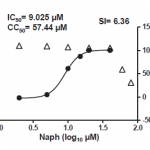The S protein of the new coronavirus (SARS-CoV-2) is divided into S1 sites that bind to the host receptors and S2 sites for membrane fusion. The boundary site of this S1 site and S2 site has a furin cleavage site, and there is a target domain of transmembrane protease serine 2 (TMPRSS2) in the S2 site. The following research has been reported that the use of inhibitors on those proteases may be able to reduce the infection of the new coronavirus.
https://linkinghub.elsevier.com/retrieve/pii/S2211-1247(20)31243-2
decanoyl-RVKR-chlorometylketone (CMK) for a furin inhibitor, camostat for a TMPRSS2 inhibitor, as well as naphthofluorescein which inhibits RNA replication, were studied. VeroE6 cells are used for the experiments.
Obtained efficacy and toxicity were as follows; the 50% inhibitory concentration (IC50) was 0.057 μM for CMK, 9.025 μM for naphthofluorescein, and 0.025 μM for camostat. The 50% cytotoxic concentration (CC50) was 318.2 μM for CMK, 57.44 μM for naphthofluorescein, and 2,000 μM for camostat. The resulting selection index is 5,567 for CMK, 6.36 for naphthofluorescein, and 81,004 for camostat.
Note that there is a difference among these inhibitors, CMK and camostat prevent the initial infection of the virus, and naphthofluorescein prevents the replication of the virus. We look forward to further consideration as a lead compound for the development of therapeutic drugs in the future.

